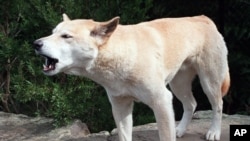New research has revealed that environmental damage caused by Australia’s 5,600-kilometer dingo fence is so vast it can be seen from space. Satellite images have documented changes on both sides of one of the world's longest human-made structures, which stretches across three Australian states.
Dingoes are descended from south Asian wolves. They are thought to have arrived in Australia with Asian seafarers about 3,500 years ago. A study of the 5,600-kilometer dingo fence in the red sand dunes of the Strzelecki Desert in central Australia has revealed what happens when a key predator is removed.
“Using 32 years of satellite images, we saw that the dynamics of the vegetation cover was different on either side of the fence,” said Adrian Fisher, a lecturer in remote sensing at the University of New South Wales. “On the side where dingoes are rare, we found many more kangaroos whose grazing lowered the grass cover across the landscape.”
Fisher said that overgrazing damages soil quality, making the ground more vulnerable to erosion.
He said dingoes not only keep kangaroo populations in check, they can also limit the ecological damage caused by feral pests.
“It is clear that dingoes keep kangaroo numbers low, and where there are dingoes there are fewer foxes and cats," he said. "This means that outside the fence it is common to find small native mammals like the dusky hopping mouse. Together with the satellite images, this research clearly shows that the removal of the apex predator has had widespread effects on the landscape and its biodiversity. To restore and conserve these ecosystems the important role of the dingo needs to be acknowledged.”
The fence was built in Australia in the early 20th century to help protect sheep.
Tearing parts of it down would threaten the livestock industry, but the authors of the university study hope that a balance can be found that restores ecosystems and protects farms.
The University of New South Wales study was published in the journal Landscape Ecology.









